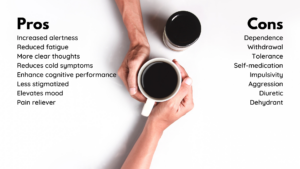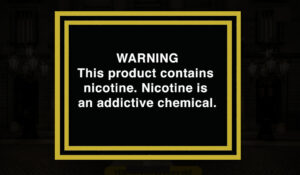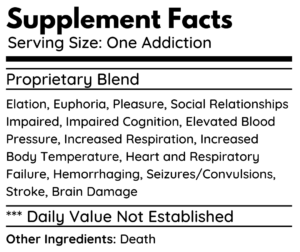Chapter 3: Stimulants
By the end of this chapter, you should be able to:
- Define the characteristics of the major classes of drugs. (LO2)
- Identify and summarize the addiction process and the characteristics thereof. (LO3)
Overview of Stimulants
Stimulants are drugs that typically increase overall levels of neural activity (Lumen; Florida State College). Drugs in this category include, but are not limited to: cocaine, amphetamines, bath salts, MDMA, nicotine, and caffeine. The most common routes for using stimulants are , intranasal or snorting, inhalation (usually smoking), and with a hypodermic syringe (Rawson, 1999; Wisconsin Technical College System). This chapter will cover some of the most common stimulants used.
Concepts to Remember:
- Many of these drugs act as (APA, 2022) of the user system (Vosburg, et al, 2021).
- The opposite of an agonist is an antagonist, which binds the drug and the receptor and halts natural function of the receptor (Nguyen, 2018).
- Furthermore, up-regulation and down-regulation play a role in abuse but also withdrawal (and relapse). Up-regulation is when the number of receptors that are fully functioning, without drug use, increases. When the number of receptors decreases, it is called down-regulation. Relapse is so prevalent because the body does not immediately recover from drug use, it needs time to return to its natural function and balance (OpenStax, 2020).
- The of a drug is important to understand how long a substance remains in the body (APA, 2022). Below are some slides and further information related to half-life. Select the double-pointed arrow, in the lower right corner to enlarge the slides.
Cocaine
Cocaine is derived from a South American shrub called coca (APA, 2022). The coca leaves contain a psychoactive component which is what we know as cocaine. For thousands of years, indigenous people have chewed coca leaves to also know as “khoka” in some cultures (Biondich & Joslin, 2016). It was chewed for numerous purposes including ceremonies and other social and physiological benefits. European and American cultures began limiting their usage of cocaine once its addictive nature and side effects became more widely known (Sanvisens, et al., 2021. However, many indigenous people still chew the coca leaves for the following benefits:
- Gastrointestinal Treatment: Relieves stomach pain, spasms, nausea, indigestion, mouth sores, tooth aches, constipation, and diarrhea.
- Environmental Stress Treatment: Relieves symptoms of hypoxia and altitude sickness and suppresses feelings of hunger and cold.
- Physiological Treatment: Stabilizes blood sugar.
Move the middle bar to the right to view an image of coca leaves; move the middle bar to the left to view cocaine.
Amphetamines

Amphetamines are synthetic drugs that stimulate the brain and have been tricked to release (APA, 2022). First synthesized in 1887 in Germany, it became a common pharmacy drug in the early 1930s. Later, it was introduced during World War II to keep troops on both sides alert for over two full days. In modern treatments, it is used to help reduce or manage the symptoms of attention deficit hyperactivity disorder (ADHD), severe depression, and narcolepsy (IUPHAR/BPS, 2022; Lueithi & Liechti, 2020; Reyes-Parada, et al., 2020). It has been used in the military for extreme cases, as well. Amphetamines produce a wide range of effects on the user, including several parts of the brain (Ferruci, 2019; Tait, et al. 2014; Tran, et al., 2021).
- Prefrontal Cortex: affects cognition and arousal
- Hypothalmus: affects food intake, thermoregulation, and arousal
- Limbic System: affects emotions, learning, memory, rewards, addiction
- Brainstem-Spinal Cord-Periphery: affects locomotion, cardiovascular and respiratory rhythm, pain perception
Plant-Based Stimulants
Review the following slides to learn more about plant-based stimulants (APA, 2022; Athukorala, et al., 2021; Drug Policy Alliance, 2022; Hon et al., 2021; USFS, 2022) Select the arrow in the lower right corner to expand the slides to full screen.
Caffeine
Caffeine is a socially acceptable stimulant that is widely used to increase alertness and performance (Agoston et al., 2022; Munis, et al., 2017). It is a plant-derived, bitter substance that is found in seeds, fruits, nuts, or leaves in plants indigenous to Africa, East Asia, and South America (“Caffeine”, 2022) (APA, 2022). Caffeine acts as a defense mechanism for plants, due to its bitter taste, keeping plant-eaters away and outliving the competition. The best known source of caffeine is coffee, which millions of people consume daily (often many times daily!) (“History”, 2022). It is the most widely consumed (and sanctioned) psychoactive drug in the world because it is legal and unregulated nearly everywhere in the world (Franke et al. (2021). Caffeine has its own slew of positive and negative affects. Review the graphic below to learn more about the pros and cons of consuming caffeine.

Nicotine

Nicotine is another plant-based stimulant that is mostly derived from tobacco plants (APA, 2022). Like caffeine, it is one of the most widely used psychoactive drugs; it is the leading cause of preventable death and disease worldwide. Nicotine, found when smoking or chewing tobacco, releases a shot of into the system which thereby increases blood pressure, respiration, heart rate, and can lead to addiction (IUPHAR/BPS, 2022). Users are often more alert, feel more calm during stressful situations, and can also act as an appetite suppressant. However, in large doses, nicotine is toxic and can eventually result in death. Some negative effects of nicotine usages include dizziness, diarrha, vomiting, spasms, and heart attact. (Mahajan, et al., 2021; Quach, et al., 2020)
Tobacco smoke is also deadly. Exposure to tobacco smoke, even from electronic cigarettes, can increase the risk for stroke, Alzheimer’s disease, schizophrenia, and other diseases. Even just the tiniest bit of smoke contained thousands of hazardous chemicals and is an addictive substance (Sharma, et al., 2022).
Withdrawal from nicotine can include the following symptoms, read more here about the symptoms and how to manage them: 7 Common Withdrawal Symptoms (CDC)
- Having the urge to smoke
- Irritable or crabby
- Feeling restless and excitable
- Lack of focus
- Difficulty sleeping
- Increase in appetite (and weight)
- Increased feelings of anxiety, sadness, or depression

References:
Agoston, C., Urban, R., Horvath, Z., van den Brink, W. & Demetrovics, Z. (2022). Self-medication of ADHD symptoms: Does caffeine have a role? Frontiers in Psychology, 13(8). doi: 10.3389/fpsyt.2022.813545
AlAteeq, D., Alotaibi, R., Saqer, R., Alharbi, N., Alotaibi, M., Musllet, R., & Alraqibah, R. (2021). Caffeine consumption, intoxication, and stress among female university students: a cross-sectional study. Middle East Current Psychiatry, 28(30). https://mecp.springeropen.com/articles/10.1186/s43045-021-00109-5
American Psychological Association (2022). Agonist. APA Dictionary of Psychology. https://dictionary.apa.org/agonist
American Psychological Association (2022). Amphetamines. APA Dictionary of Psychology. https://dictionary.apa.org/amphetamines
American Psychological Association (2022). Caffeine. APA Dictionary of Psychology. https://dictionary.apa.org/caffeine
American Psychological Association (2022). Cocaine. APA Dictionary of Psychology. https://dictionary.apa.org/cocaine
American Psychological Association (2022). Ephedra. APA Dictionary of Psychology. https://dictionary.apa.org/ephedra
American Psychological Association (2022). Half-life. APA Dictionary of Psychology. https://dictionary.apa.org/half-life
American Psychological Association (2022). Khat. APA Dictionary of Psychology. https://dictionary.apa.org/khat
American Psychological Association (2022). Nicotine. APA Dictionary of Psychology. https://dictionary.apa.org/nicotine
Athukorala, I., Tilakaratne, W., Jayasinghe, R. (2021). Areca nut chewing: Initiation, addiction, and harmful effects emphasizing the barriers and importance of cessation. Journal of Addiction. https://doi.org/10.1155/2021/9967097
Biondich, A. & Joslin, J. (2016). Coca: The history and medical significance of an ancient Andean tradition. Emergency Medicine International. https://doi.org/10.1155/2016/4048764
“Caffeine” (2022, July 9). Wikipedia. Retrieved July 14, 2022 from https://en.wikipedia.org/wiki/Caffeine
Center for Disease Control (2021). 7 common withdrawal symptoms. CDC. https://www.cdc.gov/tobacco/campaign/tips/quit-smoking/7-common-withdrawal-symptoms/index.html
Cusack, P. (2020, May 14). Addiction of Caffeine and Sugar. Open Access Journal of Addiction and Psychology, 3(5). DOI: 10.33552/OAJAP.2020.03.000575
dePaula, J. & Farah, A. (2019). Caffeine consumption through coffee: Content in the beverage, metabolism, health benefits and risks. Beverages, 5(2), 37. https://doi.org/10.3390/beverages5020037
Drug Policy Alliance (2022). What are bath salts. Drug Policy Alliance. https://drugpolicy.org/what-are-bath-salts?ms=5B1_22GoogleSEM&utm_source=GoogleSEM&utm_medium=cpc&utm_campaign=SEM&cid=7011K000001SFcBQAW&gclid=CjwKCAjwq5-WBhB7EiwAl-HEkmpYb-z-xG3FDi5s3Qfya-VBbeNkaaRhqWSJ4P8m5rPKWTXzKIeelBoCMFAQAvD_BwE
Ferruci, M., Limanaqi, F., Ryskalin, L., Biagioni, F., Busceti, C., & Forni, F. (2019). The effects of amphetamine and methamphetamine on the release of norepinephrine, dopamine, and acetylcholine from the brainstem reticular formation. Frontiers in Neuroanatomy, 13(48). https://doi.org/10.3389/fnana.2019.00048
Florida State College at Jacksonville (n.d.) General psychology. Pressbooks. Retrieved July 14, 2022 from https://fscj.pressbooks.pub/psychology/chapter/substance-use-and-abuse/
Food and Drug Administration (2018). Drugs of Abuse Home Use Test. US FDA. https://www.fda.gov/medical-devices/drugs-abuse-tests/drugs-abuse-home-use-test
Franke, A., Koller, G., Krause, D., Proebtstl, L., Kamp, F., Pogarell, O., Jebrini, T., Manz, K., Chrobok, A., & Soyka, M. (2021) Just “life coffee” or neuroenhancement by stimulants. Frontiers in Public Health, 9. https://doi.org/10.3389/fpubh.2021.640154
Hallare, J. & Gerriets, V. (2021). Half life. National Library of Medicine. https://www.ncbi.nlm.nih.gov/books/NBK554498/
“History and culture of substituted amphetamines” (2022, July 9). Wikipedia. Retrieved July 14, 2022 from https://en.wikipedia.org/wiki/History_and_culture_of_substituted_amphetamines#cite_note-Edeleanu-2
Hon, M., Kim, H., Jang, Y., Na, S., Han, B., Yoon, J., Seo, C., Lee, HJ. Lee, Y. and Kang, D. (2021). New therapeutive insight into the effect of ma huang tang on blood pressure and renal dysfunction in the L-NAME-Induced hypertension. Evidence-Based Complementary and Alternative Medicine. https://doi.org/10.1155/2021/9980429
International Union of Basic and Clinical Pharmacology / British Pharmacological Society (2022). Amphetamine. IUPHAR/BPS Guide to Pharmacology. Retrieved on July 14, 2022 from https://www.guidetopharmacology.org/GRAC/LigandDisplayForward?tab=clinical&ligandId=4804
International Union of Basic and Clinical Pharmacology / British Pharmacological Society (2022). Nicotine. IUPHAR/BPS Guide to Pharmacology. Retrieved on July 14, 2022 from https://www.guidetopharmacology.org/GRAC/LigandDisplayForward?ligandId=2585
Luethi, D. & Liechti, M. (2020). Designer drugs: Mechanism of action and adverse effects. Archives of Toxicology, 94, 1085-1133. https://link.springer.com/article/10.1007/s00204-020-02693-7
Lumen Learning (n.d.) Introduction to psychology. Lumen. https://courses.lumenlearning.com/waymaker-psychology/chapter/reading-stimulants/
Mahajan, S., Jomis, G., Quisenberry, A. (2021). Multifactorial etiology of adolescent nicotine addiction: A review of the neurobiology of nicotine addiction and its implications for smoking cessation pharmacotherapy. Frontiers in Public Health, 9. https://doi.org/10.3389/fpubh.2021.664748
Mills, L., Dar-Nimrod, I., & Colagiuri, B. (2017). Effect of genetic information and information about caffeine content on caffeine withdrawal symptoms. Scientific Reports 7(8407). https://www.nature.com/articles/s41598-017-08678-4
Munis, J., Prieto, J., Gonzalez, B., Sosa, M., Cadet, J., Scorza, C., Urbano, F., Bisagno, V. (2017). Cocaine and caffeine effects on the conditioned place preference test: Concomitant changes on early genes within the mouse prefrontal cortex and nucleus accumbens. Frontiers in Behavioral Neuroscience. https://doi.org/10.3389/fnbeh.2017.00200
Nguyen, A. (2018). Agonists and antagonists. UTS. Retrieved July 18, 2022, from https://lx.uts.edu.au/pharmacology/article/agonists-and-antagonists/
OpenStax (2020). How hormones work. LibreTexts. Retrieved on July 18, 2022 from https://bio.libretexts.org/Courses/Hanover_College/Comparative_Anatomy_and_Physiology_of_Animals/08%3A_The_Endocrine_System/8.03%3A_How_Hormones_Work
Pixorize (2021). Stimulants Mnemonic for MCAT [Video]. YouTube. https://www.youtube.com/watch?v=4i9RnuCnETY
Quach, B., Bray, M., Gaddis, N., Liu, M., Palviainen, T., Minica, C., Zellers, S., Sherva, R., Aliev, F., Nothnagel, M., Young, K., Marks, J., Young, H., Carnes, M., Guo, Y., Waldrop, A., Sey, N., Landi, M., McNeil, D., Drichel, D., … Hancock, D. (2020). Expanding the genetic architecture of nicotine dependence and its shared genetics with multiple traits. Nature Communications, 11, 5562. https://www.nature.com/articles/s41467-020-19265-z#author-information
Rawson, R. (1999). TIP 33: Treatment for stimulant use disorders: Treatment improvement protocol (TIP) 33. United States Department of Health and Human Services. https://textbooks.whatcom.edu/marketing/wp-content/uploads/sites/23/2017/06/TIP-33.pdf
Reyes-Parada, M., Iturriaga-Vasquez, P., Cassels, B. (2020). Amphetamine derivatives as monoamine oxidase inhibitors. Frontiers in Pharmacology, 10. https://doi.org/10.3389/fphar.2019.01590,
Robbins, T. (2021). Neurocognition in stimulant addiction: Commentary on Kendrick et al (2021). Psychoradiology, 1(2), 88-90. https://doi.org/10.1093/psyrad/kkab008
Rosenkranz, M., O’Donnell, A., Verthein, U., Zurhold, H., Addison, M., Liebregts, N., Rowicka, M., Bartak, M/, Petruzelka, B., Kaner, E., Martens, M-S. (2019). Understanding pathways to stimulant use: A mixed-methods examination of the individual, social, and cultural factors shaping illicit stimulant use across Europe: Study Protocol. BMJ Open, 9.
Sanvisens, A., Hernandez-Rubio, A., Zuluaga, P., Fuster, D., Papaseit, E., Galan, S., Farre, M., & Muga, R. (2021). Long-term outcomes of patients with cocaine use disorder: A 18-years addiction cohort study. Frontiers in Pharmacology, 12. https://doi.org/10.3389/fphar.2021.625610
Sharma, S., Archie, S., Kanchanwala, V., Mimun, K., Rahman, M., Zhang, Y., & Abbruscato, T. (2022, April 26). Effects of nicotine exposure from tobacco products and electronic cigarettes on the pathogenesis of neurological diseases: Impact on CNS drug delivery. Frontiers in Drug Delivery. 2. doi: 10.3389/fddev.2022.886099
Tait, R., McKetin, R., Kay, Lambkin, F., Carron-Arthur, B., Bennett, A., Bennett, K., Christensen, H., & Griffiths, K. (2014). A web-based intervention for users of amphetamine-type stimulants: 3-Month outcomes of a randomized controlled trial. JMIR Publications, 1(1). https://mental.jmir.org/2014/1/e1/
Temple, J., Bernard, C., Lipshultz, S., Czachor, J., Westphal, J., Mestre, M. (2017). The safety of ingested caffeine: A comprehensive review. Frontiers in Psychology, 8(80). doi: 10.3389/fpsyt.2017.00080
Thomas, S. (2022). How long do drugs stay in your system? (Drug half-life and drug tests). American Addiction Centers. https://americanaddictioncenters.org/how-long-drugs-system#_edn1
Tran, M., Luong, Q., Minh, G., Dunne, M., & Baker, P. (2021). Psychosocial interventions for amphetamine type stimulant use disorder: An overview of systematic reviews. Frontiers in Psychology, 10. https://www.frontiersin.org/articles/10.3389/fpsyt.2021.512076/full
United States Forest Service. (2022). Stimulants. USDA. https://www.fs.fed.us/wildflowers/ethnobotany/Mind_and_Spirit/stimulants.shtml
Vosburg, S., Robbins, R., Antshel, K., Faraone, S., & Green, J. (2021). Characterizing pathways of non-oral prescription stimulant non-medical use among adults recruited from Reddit. Frontiers in Psychology. https://doi.org/10.3389/fpsyt.2020.631792
Wisconsin Technical College System (n.d.). Nursing pharmacology. Pressbooks. https://wtcs.pressbooks.pub/pharmacology/chapter/1-6-cns-stimulants/
This is a substance that is swallowed and goes through the digestive system and enters the bloodstream when metabolized.
Substances enter the bloodstream directly through the use of a syringe and needle.
A drug or chemical agent that binds to a particular receptor and produces a desired effect. Typically these effects are similar to natural body processes.
the time necessary for the concentration in the blood of an administered drug to fall by 50%.
coupled with dopamine they control brain states, vigilance, action, and reward, learning, and memory processes.
soluble sugar that provides energy to the body. Glucose is derived from carbohydrates.

